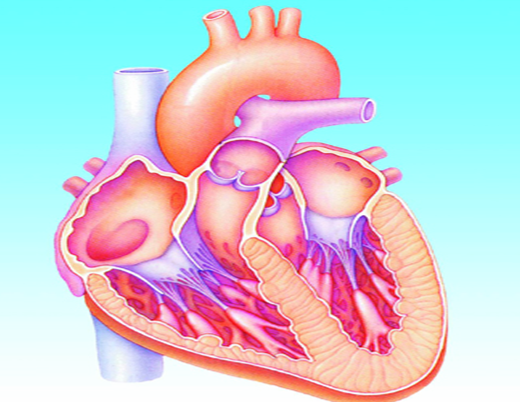Now let me draw a little line here just to keep it straight.
我畫(huà)線(xiàn)把兩部分分開(kāi)
The small artery and the arteriole, these two,
而這邊的小動(dòng)脈和微動(dòng)脈
these are actually sometimes called the muscular arteries.
則是叫做彈性動(dòng)脈
Muscular arteries, and the reason, again,
為什么叫它們彈性動(dòng)脈呢?
if you just want to look at the wall of the artery, you'll get the answer.
如果大家想一下血管壁的話(huà)就很容易理解了
The wall of the artery is actually very muscular.
血管壁中是富含肌肉的
In fact, specifically, it's smooth muscle.
確切的說(shuō),是有很多平滑肌
So not that kind of muscle you have in your heart or in your bicep, but this is smooth muscle
這跟心臟或者二頭肌的肌肉不同,這里是平滑肌
that's in the wall of the artery, and there's lots of it.
血管壁中存在大量平滑肌
So again, if you have a little blood vessel like this,
如果有這樣的一條小血管
if you imagine tons and tons of smooth muscle on the outside, so let's draw it like this.
血管壁中存在大量平滑肌,我們畫(huà)一下
Little bands of smooth muscle.
有很多平滑肌
If those bands decide that they want to contract down, if they want to squeeze down,
如果這些肌肉要收縮,血管要發(fā)生擠壓
you're going to get something that looks like a little straw because those muscles are now tight.
現(xiàn)在血管就有點(diǎn)像一條吸管,因?yàn)楝F(xiàn)在肌肉都是緊張的
They are tightly wound, right?
都是收縮緊繃的
So you're going to create like a little straw, and this process is called vasoconstriction.
這樣就有點(diǎn)像一根吸管,這個(gè)過(guò)程就叫做血管收縮
Vaso- just means blood vessel, and constriction is, kinda, tightening down.
詞首vaso意思是“血管”,constriction意思是“收縮”
So vasoconstriction, tightening down of the blood vessel,
這個(gè)詞意思就是血管收縮
and what that does is it increases resistance, right?
血管收縮就會(huì)增加血流阻力
Just like if you're trying to blow through a tiny, tiny little straw, there's a lot of resistance.
比方說(shuō),如果向很細(xì)的吸管吹氣,阻力是很大的

Well, it's the same idea here, and actually a lot of that resistance and change in the constriction,
這里也是一樣,血流阻力非常大
or vasoconstriction, is happening at the arteriole level.
在小動(dòng)脈的層面,影響血管收縮
So that's why they're very special, and I want you to remember them.
這是它們特殊的地方,大家要記住
From there, blood is going to go through the capillaries.
然后血液進(jìn)入毛細(xì)血管
I didn't actually label them the first time, but let me just write that here.
上次我沒(méi)有標(biāo)記毛細(xì)血管,我寫(xiě)在這
Sometimes, they call them capillary beds.
有時(shí)這里也叫毛細(xì)血管床(網(wǎng))
I'll write that out,
我寫(xiě)一下
and then it's going to go and get collected in the venules and eventually into the veins,
再往后,就到了小靜脈,靜脈
and the important thing about the veins,
關(guān)于靜脈還有一點(diǎn)需要注意
I'm going to stop right here and just talk about it very briefly, is that they have these little valves,
我們?cè)谶@里停一下,一起來(lái)看一下,這里有一些瓣膜
and these valves make sure that the blood continues to flow in one direction.
瓣膜存在的目的是確保血液流動(dòng)的方向正確
So one important thing here is the valves,
關(guān)于瓣膜有些要點(diǎn)
and remember the other important thing is that they are able to deal with large volumes.
一是應(yīng)對(duì)大血量的情況,二就是確保流動(dòng)方向正確
So unlike the arteriole side, where it's all about large pressure,
這里并不像高壓的小動(dòng)脈
down here with the vein side, we have to think about large volumes.
靜脈這里要考慮的,是大血量
Remember, about two-thirds of your blood at any point in time is sitting in some vein or venule somewhere.
大家記住,在任何時(shí)間身體中大約2/3的血液是在靜脈和小靜脈中的



